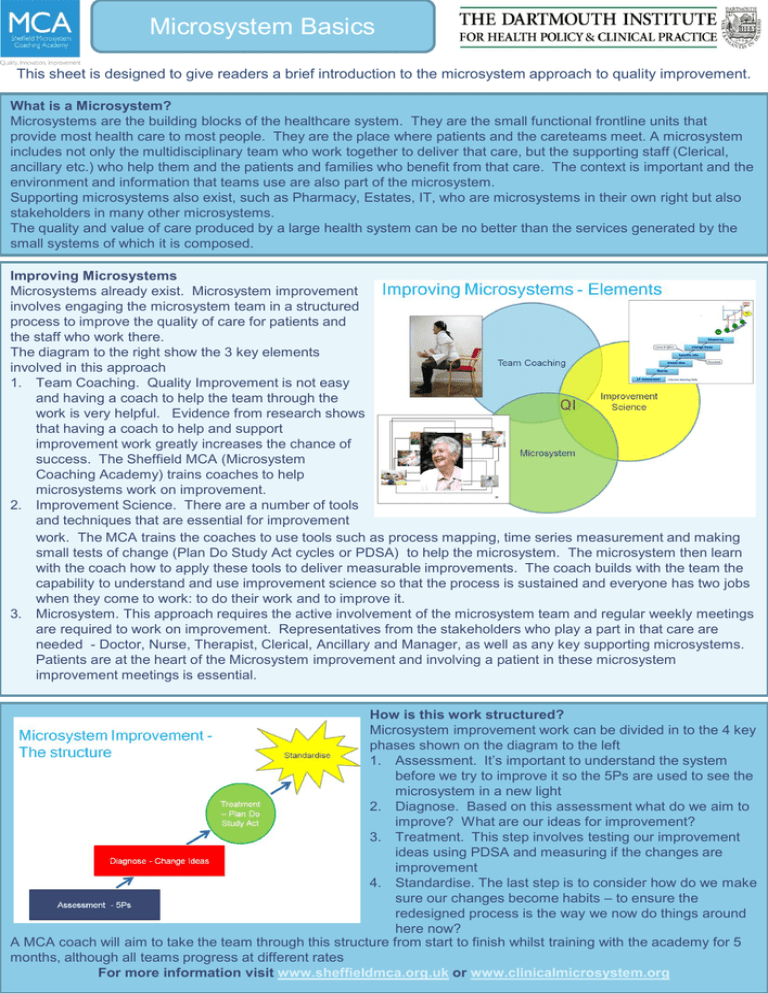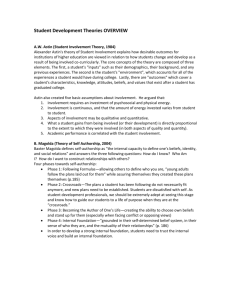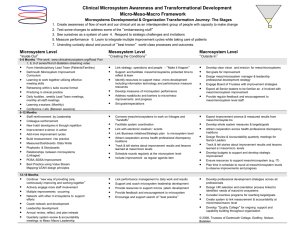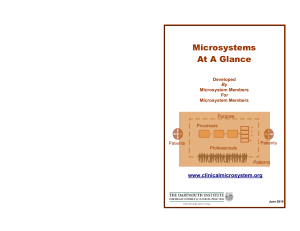here - Sheffield Microsystem Coaching Academy
advertisement

Microsystem Basics This sheet is designed to give readers a brief introduction to the microsystem approach to quality improvement. What is a Microsystem? Microsystems are the building blocks of the healthcare system. They are the small functional frontline units that provide most health care to most people. They are the place where patients and the careteams meet. A microsystem includes not only the multidisciplinary team who work together to deliver that care, but the supporting staff (Clerical, ancillary etc.) who help them and the patients and families who benefit from that care. The context is important and the environment and information that teams use are also part of the microsystem. Supporting microsystems also exist, such as Pharmacy, Estates, IT, who are microsystems in their own right but also stakeholders in many other microsystems. The quality and value of care produced by a large health system can be no better than the services generated by the small systems of which it is composed. Improving Microsystems Microsystems already exist. Microsystem improvement involves engaging the microsystem team in a structured process to improve the quality of care for patients and the staff who work there. The diagram to the right show the 3 key elements involved in this approach 1. Team Coaching. Quality Improvement is not easy and having a coach to help the team through the work is very helpful. Evidence from research shows that having a coach to help and support improvement work greatly increases the chance of success. The Sheffield MCA (Microsystem Coaching Academy) trains coaches to help microsystems work on improvement. 2. Improvement Science. There are a number of tools and techniques that are essential for improvement work. The MCA trains the coaches to use tools such as process mapping, time series measurement and making small tests of change (Plan Do Study Act cycles or PDSA) to help the microsystem. The microsystem then learn with the coach how to apply these tools to deliver measurable improvements. The coach builds with the team the capability to understand and use improvement science so that the process is sustained and everyone has two jobs when they come to work: to do their work and to improve it. 3. Microsystem. This approach requires the active involvement of the microsystem team and regular weekly meetings are required to work on improvement. Representatives from the stakeholders who play a part in that care are needed - Doctor, Nurse, Therapist, Clerical, Ancillary and Manager, as well as any key supporting microsystems. Patients are at the heart of the Microsystem improvement and involving a patient in these microsystem improvement meetings is essential. How is this work structured? Microsystem improvement work can be divided in to the 4 key phases shown on the diagram to the left 1. Assessment. It’s important to understand the system before we try to improve it so the 5Ps are used to see the microsystem in a new light 2. Diagnose. Based on this assessment what do we aim to improve? What are our ideas for improvement? 3. Treatment. This step involves testing our improvement ideas using PDSA and measuring if the changes are improvement 4. Standardise. The last step is to consider how do we make sure our changes become habits – to ensure the redesigned process is the way we now do things around here now? A MCA coach will aim to take the team through this structure from start to finish whilst training with the academy for 5 months, although all teams progress at different rates For more information visit www.sheffieldmca.org.uk or www.clinicalmicrosystem.org In practical terms what happens? Microsystem improvement requires commitment and ownership from the team. Engagement from stakeholders and a willingness to get involved are prerequisites. Leaders will need to give the staff time and space to work on improvement. The work breaks down into 3 key phases as shown on the diagram. 1. Pre Phase. The coach works with the leader and the The Team Coaching Model team to set the scene for improvement. This involves expectation setting and agreement, a site visit and other introductory meetings so the coach can understand the context of the microsystem and the team can start to learn about the improvement Transition Action Phase approach. Pre Phase Phase Art & Science of ` Getting Ready 2. Action Phase. This is where the team work on Reflection, Coaching improvement using weekly meetings. Ground rules Celebration & Renew will be set with the team. Time is precious so the coach will introduce effective meeting skills to maximise the benefit of this time. The team will then work through the structure of assessing, diagnosing Godfrey, MM (2012) In Press and treating the system. 50 Jude The action phase can take around a year and often the first PDSA are small scale changes to build confidence before the team move on to larger and more complex improvements. 3. Transition Phase. Once the team have confidence using the improvement tools the coach will begin to transition out so the team can continue without the active weekly involvement of the coach. This phase includes assessing and reflecting what has been learnt through the process and celebrating success. The coach will be mindful of this process and will teach the team the skills to carry on improving their own system after this transition phase. The coach will then move on to coach a new team. What has been achieved elsewhere? Over 50 teams have worked on microsystem improvement across STH, SCH and the care trust. Examples include• It has been satisfying for me personally to be able to start to change a system that I thought we were stuck with and that we all hated - staff and patients. • • • • We can’t just carry on and let other people just decide for us. If we want something doing, we’ve got to get involved…” • • • Orthopaedics foot and ankle reduced wait for surgery from admission from 5.5 hours to 2 hours and added 1 case to each list Diabetic foot clinic reduced waiting in clinic by 54% Oncology outpatients reduced the clinic note preparation time by 50% Renal surgery reduced delays between cases to 3 mins and improved start times by 25 minutes Hearing services increased the number of patients seen in less than 48 hours from 20% to 77% Cystic fibrosis redesigned clinic so patients wait on average 8 minutes and reduced diagnostic testing by £15,000 per year Renal reduced the DNA rate from 11% to 6% and reduced clinic waiting by 63% Infectious diseases reduced new patient DNA from 55% to 32% What are the keys to success? • Leadership enabling time and space for improvement work to happen. • Following the structure as it helps you make measurable sustainable improvements • Assessing the system before deciding on solutions. • Improvement work is 80% human and 20% technical using the teams knowledge and skills • Giving the team ownership of ideas and decisions what to improve and how to improve it. • Involving patients in the work from the start • Starting small to build confidence. • Using measurement to show that changes are measurable improvements Just from a morale point of view the improvement work has done a lot of good Everybody is more positive and thinking: ‘yes, actually, something can be done Relationships within the team have really improved Significant changes have been made which have benefitted patients and staff More Information? Websites www.sheffieldmca.org.uk www.clinicalmicrosystem.org Books Quality by Design (Nelson, Batalden, Godfrey) Value by Design (Nelson, Batalden, Godfrey, Lazar) Contacts by Phone or Email – steve.harrison@sth.nhs.uk – Extn 13698 patrick.richmond@sth.nhs.uk – Extn 68255 jude.stone@sch.nhs.uk Extn 53067











